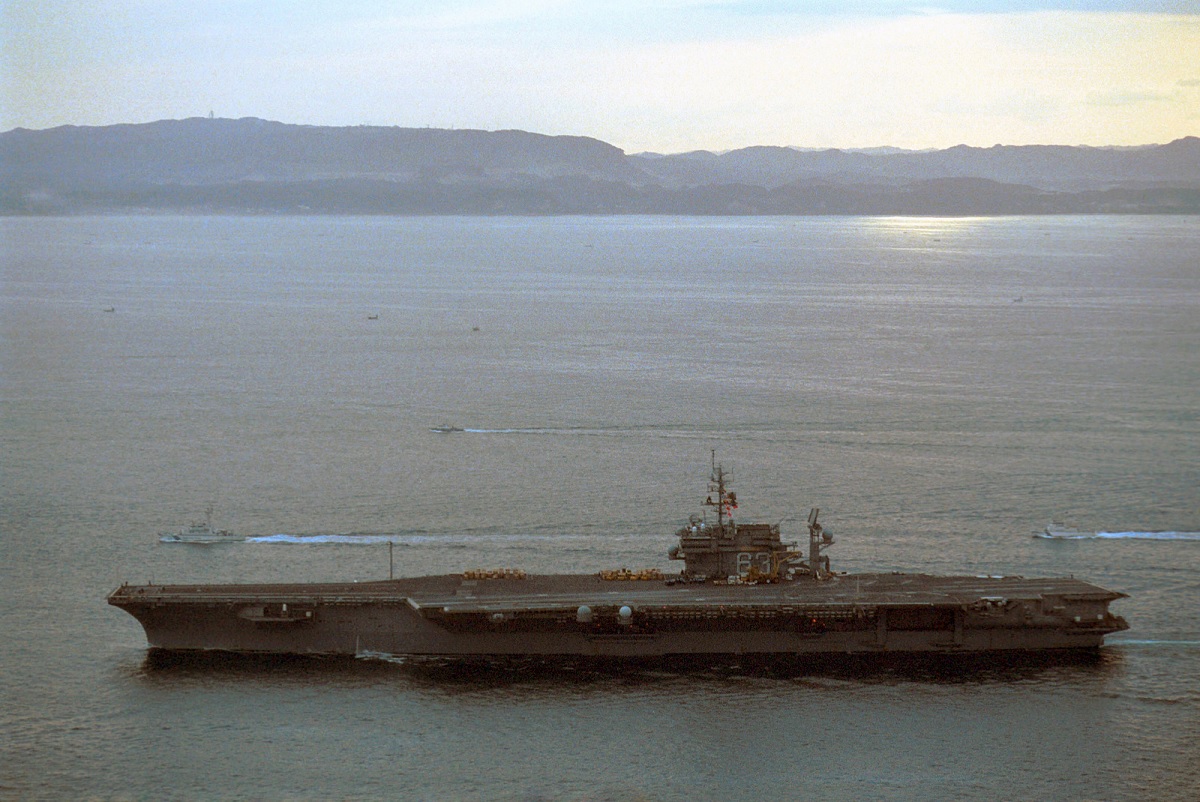The day K-314 submarine rammed USS Kitty Hawk aircraft carrier
On Mar. 21, 1984, while US Navy Battle Group Bravo sailed southerly courses toward the Tsushima Strait into the Yellow Sea during Exercise Team Spirit 84-1, Soviet submarine K-314, a Victor I-class attack boat, collided with USS Kitty Hawk (CV-63) aircraft carrier while surfacing.
The collision occurred at 2207, about 150 miles east of Pohang, South Korea, in the Sea of Japan, near 37º3’N, 131º54’E. Captain David N. Rogers, the ship commander, on the bridge, felt a “noticeable shudder, a fairly violent shudder,” and he and the starboard lookout saw the outline of the sub’s sail moving away from Kitty Hawk, the sub failing to display navigation lights.
According to Naval History and Heritage Command, RADM Richard M. Dunleavy, Director, Carrier (CV) and Air Stations Program, later noted that during the previous three days, the sub was detected by helos launched from Battle Group Bravo “and killed more than 15 times,” the Victor I initially being sighted on the surface 50 nautical miles ahead of the carrier’s intended course before submerging, on Mar. 19.
K-314 Captain was at fault
Responsibility for the collision lay with Vladimir Evseenko, the K-314 captain, as David Hornbuckle, former US Navy Submariner and Nuclear Power Plant Mechanical Operator MM1/SS at US Navy, explains on Quora.
‘The Soviet submarine K-314 surfaced at 22:05 (10:05 PM) in front of the USS Kitty Hawk CV-63. The K-314, surfaced in front of the bow of the carrier at night and too close for either vessel to avoid the collision.
‘It is a normal practice for submarines, when surfacing, to verify the area is clear of other vessels. Most submarines do a sonar sweep using passive sonar, plus the K-314 was shadowing the carrier task force in an attempt to gather intelligence, so I am fairly certain the K-314 did not do an active sonar sweep.

‘When surfacing, the periscope is raised (I am telling this from an American perspective since I served on two US submarines) and as soon as the scope breaks the surface, the OOD or Captain does a visual sweep for other vessels in the area.
‘Small boats and large vessels which are sitting still (some ships have to wait outside a port for high tide or a harbor pilot to enter port) make very little noise and can be missed on passive sonar.’
The sonar crew on the K-314 missed the sound of USS Kitty Hawk
Hornbuckle continues.
‘How the sonar crew on the K-314 missed the sound of an 82,000 ton aircraft carrier bearing down on them is beyond comprehension barring a failure in their sonar system.
‘It is the submarines’ fault for surfacing directly in front of an underway aircraft carrier.
‘As for how it happened, I have an idea on how it might have went. Soviet submarine commanders are known to be reckless when compared to American captains.
‘I can see a scenario where a Soviet captain, during the height of the Cold War, would want to surface his sub in the middle of an American carrier task force as a ploy to try to prove the superiority of Soviet technology and Soviet seamanship.
‘Using his sonar to position his sub in the Sea of Japan, which has a reputation for poor sonar operation at times, the Soviet captain thought he had positioned his boat perfectly.
‘Unknown to the Soviet captain, the aircraft carrier had gone to flight ops changing direction to head into the wind and increasing speed of the carrier.’
Hornbuckle concludes:
‘It could have been bad timing that just as the Soviet captain surfaced his sub, the carrier had gone to flight ops and instead of being off his port or starboard side, the carrier was heading straight at him at 30 knots. No time to react or avoid the collision.

K-314 captain humiliation
‘Instead of a propaganda success, it becomes a humiliation of the captain. Why the Soviet sonar failed to detect the USS Kitty Hawk is still the question about the incident that I would love to know the answer to. Whether this is what occurred that night, I don’t know. Just some thoughts from a former submariner.’
After the accident, Kitty Hawk immediately launched ‘two helicopters to see if we could render any assistance to them but the Soviet sub appeared to have suffered no extensive damage,’ Rogers recalled.
K-314’s propeller was heavily damaged as a result of the collision. Kitty Hawk instead had a huge hole in its bow, causing several thousand tons of jet fuel to leak into the sea; by sheer miracle, it did not explode.
Luckily, nor did the nuclear weapons on board the Soviet and American vessels detonate.
Close escorted by a US Navy frigate for part of the route, the Soviet Submarine was towed to the nearest Soviet naval base.
For USS Kitty Hawk, exercise Team Spirit was over: the aircraft carrier in fact made its way to the port of Subic Bay for repair.
The Americans blamed the Soviet submarine captain for the incident, and the Soviet Naval command concurred. Vladimir Evseenko was suspended from the post of captain and continued his service on land.
Evseenko could not agree with such verdict, since the incident had caused no loss of life or the submarine itself: “Everybody was lucky. We didn’t sink, no one got burned.”
“We even managed to kick out the ‘enemy’ for a long time,” he pointed out.

Photo by U.S. Navy

